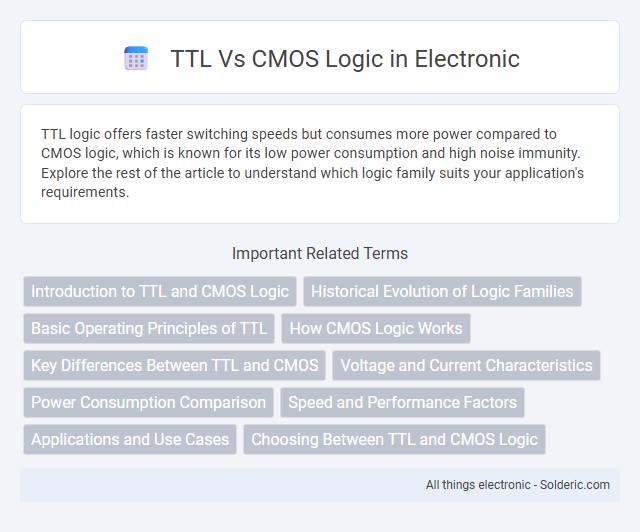TTL logic offers faster switching speeds but consumes more power compared to CMOS logic, which is known for its low power consumption and high noise immunity. Explore the rest of the article to understand which logic family suits your application's requirements.
Comparison Table
| Feature | TTL (Transistor-Transistor Logic) | CMOS (Complementary Metal-Oxide-Semiconductor) |
|---|---|---|
| Technology | Bipolar junction transistors (BJT) | Complementary MOSFETs (NMOS and PMOS) |
| Power Consumption | Higher, constant static power | Very low static power, dynamic power dominates |
| Switching Speed | Moderate to high speed | High speed, improving with scaling |
| Voltage Levels | 5 V standard | Wide range (1.2 V to 15 V typical) |
| Noise Immunity | Moderate | High noise immunity |
| Input Impedance | Low | Very high |
| Integration Density | Low to medium | Very high |
| Cost | Higher | Lower |
| Applications | Legacy circuits, some high-speed logic | Modern ICs, microprocessors, low-power devices |
Introduction to TTL and CMOS Logic
TTL (Transistor-Transistor Logic) utilizes bipolar junction transistors to perform logic operations, offering fast switching speeds and moderate power consumption, making it suitable for early digital circuits. CMOS (Complementary Metal-Oxide-Semiconductor) technology employs complementary pairs of p-type and n-type MOSFETs, resulting in low static power consumption and high noise immunity, widely used in modern integrated circuits. The fundamental difference between TTL and CMOS logic lies in their transistor structures and power characteristics, influencing their performance, speed, and energy efficiency in digital electronics.
Historical Evolution of Logic Families
TTL (Transistor-Transistor Logic) emerged in the 1960s as a faster and more reliable alternative to earlier resistor-transistor logic, becoming the dominant logic family for digital circuits due to its robust switching speeds and noise immunity. CMOS (Complementary Metal-Oxide-Semiconductor) technology evolved later, gaining prominence in the 1980s with its significantly lower power consumption and higher density integration, enabling more complex and energy-efficient designs. Your choice between TTL and CMOS logic families depends on requirements for power efficiency, speed, and circuit complexity, influenced by this historical evolution.
Basic Operating Principles of TTL
TTL (Transistor-Transistor Logic) operates using bipolar junction transistors (BJTs) to perform logic functions by switching transistors between saturation and cut-off states, enabling fast switching speeds. The input stage of TTL typically consists of multiple-emitter transistors that allow multiple inputs to be processed simultaneously, creating efficient AND-OR logic structures. TTL circuits consume more power compared to CMOS but excel in providing robust noise margins and faster switching suitable for many digital applications.
How CMOS Logic Works
CMOS logic operates by using complementary pairs of p-type and n-type MOSFETs to achieve low power consumption and high noise immunity. When one transistor type is on, the other is off, ensuring minimal current flow except during switching transitions. This design allows CMOS circuits to maintain stable, efficient operation while producing output voltages close to the supply rails.
Key Differences Between TTL and CMOS
TTL logic gates operate using bipolar junction transistors, resulting in faster switching speeds but higher power consumption compared to CMOS, which relies on complementary MOSFETs and features low power usage with high noise immunity. TTL circuits typically have fixed input and output voltage levels, while CMOS offers a wider voltage range and higher input impedance, enhancing signal integrity. Understanding these key differences helps you select the proper logic family for speed-critical or low-power applications in digital circuit design.
Voltage and Current Characteristics
TTL logic operates with a typical voltage range of 0.8V for low and 2V for high, drawing higher current due to its bipolar transistor design, resulting in faster switching but increased power consumption. CMOS logic features wider voltage thresholds, generally 0.3V to 0.7V of the supply voltage for clear low and high levels, with significantly lower current draw as it relies on MOSFETs, enhancing power efficiency. Understanding these voltage and current characteristics helps you choose the right logic family for power-sensitive or speed-critical electronic applications.
Power Consumption Comparison
TTL logic circuits typically consume more power compared to CMOS logic due to their constant current flow in the output stage, whereas CMOS devices draw significant power only during switching events. CMOS technology offers superior energy efficiency, making it ideal for battery-powered and low-power applications, as static power dissipation is minimal. Understanding these differences can help you select the appropriate logic family to optimize your circuit's power consumption.
Speed and Performance Factors
TTL logic circuits generally offer faster switching speeds compared to CMOS at lower frequencies due to their bipolar transistor structure, which provides rapid current changes. CMOS technology excels in high-speed performance at advanced nodes, delivering lower power consumption and scalability, making it suitable for modern high-frequency applications. Your choice between TTL and CMOS should consider speed requirements along with power efficiency and integration density for optimal performance.
Applications and Use Cases
TTL logic is widely used in high-speed digital circuits such as computer processors and communication devices due to its fast switching times and reliable noise margins. CMOS logic dominates in battery-powered and portable applications like smartphones and microcontrollers because of its low power consumption and high integration density. Both technologies are essential in mixed-signal environments where performance trade-offs between speed and power efficiency are critical.
Choosing Between TTL and CMOS Logic
Choosing between TTL (Transistor-Transistor Logic) and CMOS (Complementary Metal-Oxide-Semiconductor) logic depends on factors such as power consumption, switching speed, and noise immunity. CMOS logic offers significantly lower power consumption and higher noise immunity, making it ideal for battery-powered devices and large-scale integration. TTL logic, meanwhile, provides faster switching speeds and better performance in noisy environments, often preferred in applications requiring robust, high-speed signal processing.
TTL vs CMOS logic Infographic

 solderic.com
solderic.com